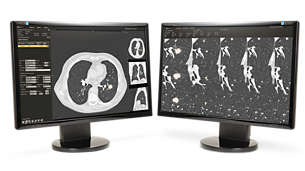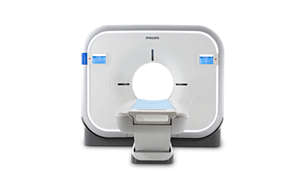Let’s close the gap
Lung cancer remains the leading cause of cancer-related deaths.1 Early detection via screening and/or follow-up of incidental findings is critical because of the asymptomatic nature of lung cancer in its early stages. Without early detection, diagnosis and treatment are often late stage, resulting in much poorer outcomes.2 Making sure every patient that is identified with an incidental finding is followed up and making sure eligible patients are being screened are two ways that the gap can be closed today.
Changes in Lung cancer screening guidelines and the newly expanded coverage by the Centers for Medicare and Medicaid Services have nearly doubled the number of people eligible for lung cancer screening, with the largest eligibility increases seen in minority populations, who’ve been shown to have a higher risk for lung cancer at younger ages.2 Without a systematic approach in place, manually managing such programs can be prohibitively time- and resource-intensive. Apart from screening, only 29% of incidental lung nodules receive appropriate follow-up.3
Philips can partner with you to support your program for early detection of lung cancer. Addressing these areas can help close gaps of inequities and find more lung cancer in early stages. We can help assess where you are today and build an approach to help expand the efficacy and reach of your screening program, as well as improve both the identification and follow-up of patients with incidental nodule findings.
Did you know?

87% of eligible Medicare and Medicaid patients are not screened for lung cancer, despite having insurance coverage4.

Approximately 71% of all incidental lung nodules are not followed and managed appropriately3.

Actionable incidental lung nodules show a malignancy rate of 25%[5].

When diagnosed early and resected immediately, a lung cancer patient’s chance of survival in 10 years jumps to 92%6.

CT screening reduces 10-year lung cancer mortality by 33% for women and 24% for men, compared to no screening7.

Lung cancer screening remains vastly underused to date, with less than 20% of the high-risk, eligible population undergoing lung cancer screening. Low rates of lung cancer screening are even more noticeable among underserved populations8.
Orchestrating an effective early detection program for lung cancer
Philips can help by providing solutions to manage lung screenings and workflows for incidental pulmonary findings while fostering collaborative treatment decision-making. This means reliably keeping track of patients, including finding and following up with those who have incidental nodules.
Keep patients engaged with an immersive experience for patient comfort and ease during the scan. Excellence in CT imaging and in visualization and reporting of results adds to the success of your program.
Key capabilities in early detection of lung cancer
-
Lung Cancer Orchestrator
The Philips Lung Cancer Orchestrator is an integrated lung cancer patient management system for both CT lung screening programs and incidental pulmonary findings programs that monitors patients through various steps of their lung cancer screening and treatment decision journey. Enhancing confidence with automated tools, the Lung Cancer Orchestrator helps identify and keep more patients – and streamline workflows. Providing a complete solution, the system also comes equipped with the Multidisciplinary Team Orchestrator to help facilitate collaborative clinical decision making.
841017 -
DynaCAD Lung
DynaCAD Lung is a vendor neutral Computer-Aided Detection (CAD) system that provides a robust set of automated tools for radiologists to analyze multi-slice CT exams of the chest. With flexible report templates and automated image registration, DynaCAD Lung helps facilitate synchronous display and navigation of multiple patient exams for initial review and easy follow-up comparison of current and prior study findings.
784022 -
Incisive CT
Incisive CT helps you meet some of your organization’s most pressing challenges and supports your mobile imaging/screening initiatives. Philips Incisive CT offers intellect at every step, from acquisition through results, and across all fronts: financial, clinical and operational. Like never before, operator and design efficiencies come together for wise decisions from start to finish with an unprecedented Tube for Life guarantee¹.
728143
Look to the leaders
The Philips solution for lung cancer orchestration is in use at lung cancer screening programs such as the newly announced program at the Ohio State University Wexner Medical Center, which detects approximately 10,000 lung nodules in a year.12
Find the clinically relevant details
Philips CT solutions such as Incisive CT meet ACR guidelines for low-dose lung cancer screening and have advanced noise reduction to improve image quality so you can see what you need to see, when you need to see it.

If there’s anything that keeps me up at night, it’s ‘Are we missing anyone?’ I sleep better at night now knowing that we have a true system that reminds us and tracks those folks in their journey along the incidental nodule and lung screening pathway.”
Dr. Bill Mayfield
Chief Surgical Officer, Wellstar Health System
Would you like to know more about scaling your program for early detection of lung cancer?
Philips can assess where you are today to help you expand the reach of early detection of lung cancer in your community. Explore our innovative financing options and learn how we can help you successfully orchestrate a lung cancer early detection program.
Dive deeper
-
![What if you could orchestrate clear care pathways for every patient?]()
What if you could orchestrate clear care pathways for every patient?
Learn more -
![Oncology solutions]()
Oncology solutions
Learn more
Related solutions
References
Results from case studies are not predictive of results in other cases. Results in other cases may vary.
1 International Agency for Research on Cancer, World Health Organization. Press Release N° 263. Latest global cancer data: Cancer burden rises to18.1 million new cases and 9.6 million cancer deaths in 2018. 12 September 2018.
2 Lane E, et al. Nearly twice as many people are now eligible for lung cancer screenings—here is what you need to know. Advisory Board publication. 2021.Washington, DC. www.advisory.com/sponsored/lung-cancer
3 Blagev DP, et al. Follow-up of incidental pulmonary nodules and the radiology report. J Am Coll Radiol. 2014;11:378-83. DOI: 10.1016/j.jacr.2013.08.003.
4 www.beckershospitalreview.com/oncology/87-of-eligible-patients-not-undergoing-lung-cancer-screening-analysis-finds
5 Tanner NT, et al. Management of pulmonary nodules by community pulmonologists: a multicenter observational study. Chest. 2015 Dec;148(6):1405-1414. doi: 10.1378/chest.15-0630. PMID: 26087071; PMCID: PMC4665735.
6 International Early Lung Cancer Action Program Investigators. Survival of patients with stage 1 lung cancer detected on CT screening. N Engl J Med. 2006;355:1763- 1771 DOI: 10.1056/NEJMoa060476.
7 Aberle DR, et al. The National Lung Screening Trial Research Team. Reduce lung-cancer mortality with low-dose computed tomographic screening. N Engl J Med. 2011;365(5):395-409. DOI: 10.1056/NEJMoa1102873.
8 Olazagasti C, et al. Let's Close the Gap: #ASCO21 Research Addresses Disparities in Lung Cancer Screening. ASCO Daily News. 2021. dailynews.ascopubs.org/do/10.1200/ADN.21.200659/full/
9 Fact Sheet: President Biden reignites cancer moonshot to end cancer as we know it. White House Briefing. February 2, 2022. www.whitehouse.gov/briefing-room/statements-releases/2022/02/02/fact-sheet-president-biden-reignites-cancer-moonshot-to-end-cancer-as-we-know-it/
10 Statement from the American College of Radiology. July, 2020. www.acr.org/Media-Center/ACR-News-Releases/2020/Updated-USPSTF-Lung-Cancer-Screening-Guidelines-Would-Help-Save-Lives
11 Khorana A, et al. Increase in time to initiating cancer therapy and association with worsened survival in curative settings: A U.S. analysis of common solid tumors. J Clin Oncol. 2017;35(15_suppl): 6557-6557. DOI: 10.1200/JCO.2017.35.15_suppl.6557.
12 “New program aims to catch hundreds of early lung cancers.” wexnermedical.osu.edu/departments/innovations/pulmonology/new-lung-cancers-program











